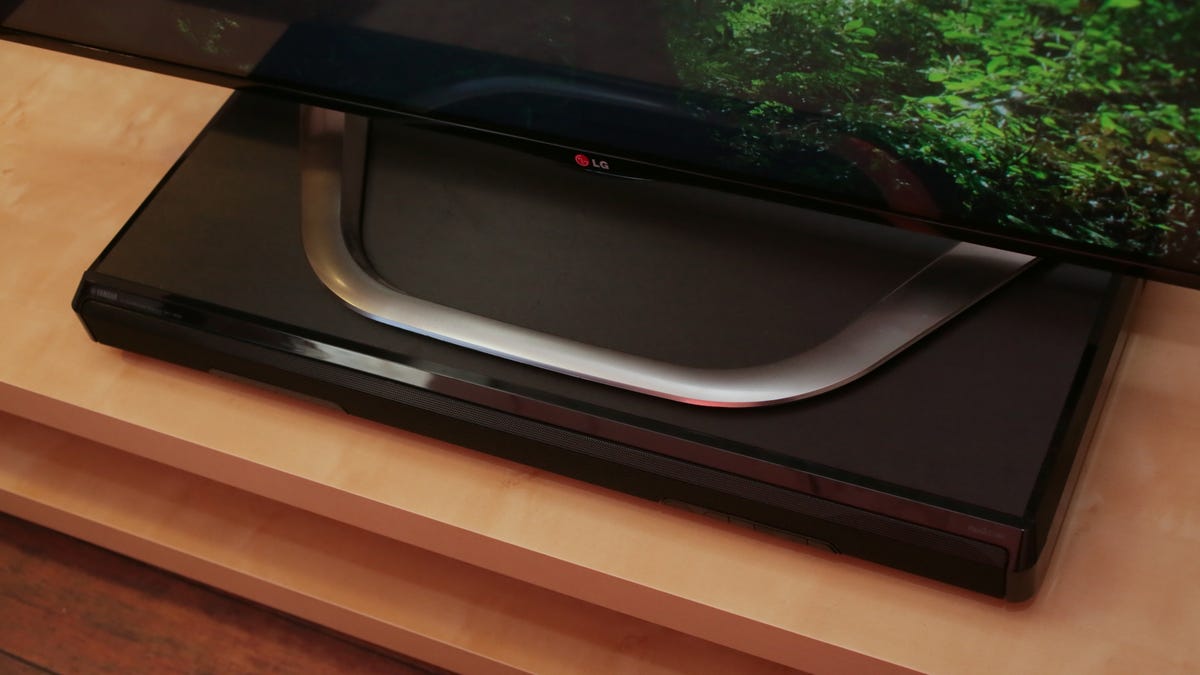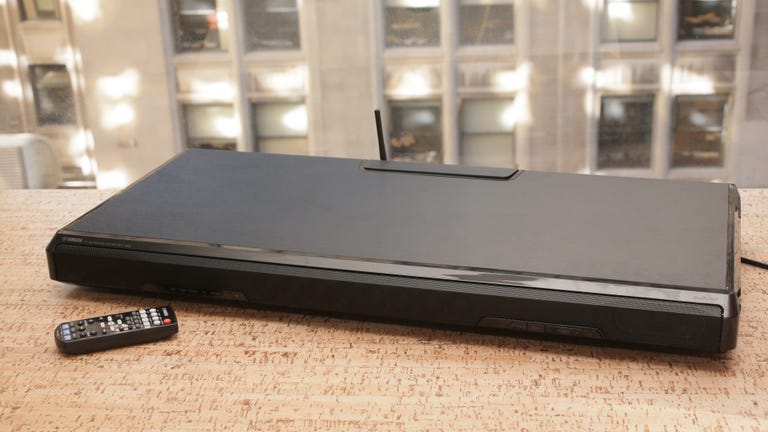 Why You Can Trust CNET
Why You Can Trust CNET Yamaha SRT-1500 review: Sound base sounds good and surrounds great -- for a price
With cutting-edge surround from a single box, the Yamaha SRT-1500 offers great sound, but it's not the best value in the company's speaker range.
What a difference twelve months makes. In 2014, the sound base -- the speaker that doubled as a base for your television--was the "next big thing" in home-theater audio. But just as things looked good for the category, many television manufacturers started changing from a central pedestal stand to the more stable, but less sound base-friendly, splayed-leg designs. As a result, even brands such as Zvox, which started the sound base trend, have started producing the more versatile sound bars.
The Good
The Bad
The Bottom Line
Nevertheless, Yamaha is forging ahead with its sound base plans by updating the existing SRT-1000 with a couple of intriguing features. The SRT-1500 is a good sounding unit with plenty of wallop in movies and acceptable music replay. But with identical performance to the earlier model, you've got to really want HDMI switching and Yamaha's proprietary music-streaming service to pay the extra $200.
In terms of pure value-for-money, the SRT-1000 is a better buy. And if you really want multiroom audio, you could buy a Chromecast Audio, pocket the extra $150 or so, and hook your cable box's HDMI video output directly to your TV.
Design

If you have a TV with a centrally-mounted pedestal stand, like the one pictured above, the Yamaha will support screen sizes up to 55-inches. As a base it doesn't matter what the height is because the TV sits on top, but nevertheless the SRT-1500 is fairly squat at only 3 inches tall. It also measures 30.75 inches wide and 14.6 inches deep.
The unit is constructed from MDF (medium-density fiberboard) and covered with the near-ubiquitous brushed vinyl wrap also seen on products from ELAC and Klipsch. Be aware that this finish mars rather easily, and a TV could easily gouge some nice holes over the lifetime of the product.
The front panel houses the the main controls, including volume and dedicated source indicators, and the drivers are protected by an attractive metal grille.
While the inputs are at the back of the cabinet, there is also a convenient hatch built into the top of the unit, which means you don't need to get behind your TV unit to plug new things in.
The menu system is a little perfunctory, and sometimes not all that intuitive. For example to access network settings there's no "Page 1" "Page 2" prompt, you just need to know to press the setup button twice.
The remote control is a step above most sound bar offerings in that it's an actual remote, not a credit card-size toy. There are even pictograms to explain the different sound options.
Features
If it wasn't for the different model number printed on the front you'd swear this was the SRT-1000, the cheaper sound base Yamaha released in 2014. And if you don't fumble around at the back of the unit, you'd struggle to see what the differences are. There are two main features the extra cash buys: the SRT1500 offers a 4K-compatible HDMI input and output, as well as Yamaha's own MusicCast multiroom audio system. Otherwise, the two are essentially identical.
The SRT-1500 uses eight directional "beam" drivers that direct the sound around your room and which are flanked by two more "traditional" oval stereo drivers. The beam drivers use phase-shifted technology to aim the beams at your walls. For bass, the SRT-1500 boasts two 3.25-inch "subwoofers" that can get down to a claimed 45Hz.
While most of its competitors can only decode Dolby, the Yamaha can handle both Dolby Digital and DTS Digital Surround. This makes the speaker an all-rounder, suited to both TV audio and the surround soundtracks of Blu-rays and DVDs.
The Yamaha comes with a number of different preset modes but according to local Yamaha representatives the main effects are Clear Voice, TV and Stereo. While Movies and Music appear on the remote, these modes don't appear to work.
The HDMI 2.0 connectors include compatibility with 60p 4K sources as well as Audio Return Channel (for listening to your TV's audio). The base also has a digital optical input in addition to an analog input, and a subwoofer out if you require more bass.
Like most powered speakers these days, the SRT-1500 includes support for Bluetooth (both streaming to and from), with the addition of support for aptX which can improve sound quality with compatible devices. But the main reason you'd buy this unit over the SRT-1000 is for MusicCast.
MusicCast is Yamaha's answer to Sonos, a multiroom system that integrates multiple streaming services in addition to DLNA. The Wi-Fi-based service offers a number of benefits including support for hi-res music and the ability to use it a wide range of Yamaha products including its 2015 receivers (as with all such systems, you'l need a MusicCast product for every room). It's one of the slickest multiroom options out there, but like all of these multiroom apps, it takes an initial learning curve. Of the services you would want it includes only Pandora, Spotify Connect, Rhapsody and Sirius -- not the most complete lineup, but OK.
Performance
The Yamaha SRT-1500 not only looks like the SRT-1000, the two speakers sound alike. We can say that because we still have the SRT-1000 on hand, and compared the two sound bases, and were thoroughly impressed with the sound of both of them!
We started our SRT-1500 auditions with the recently released "Roger Waters: The Wall" concert Blu-ray. The music's wide dynamic range didn't faze the SRT-1500 one bit, and there was plenty of power to fill our compact CNET listening room with sound. The quiet snatches of sound effects between the music that comprises "The Wall" really showed off the SRT-1500's "surround" capabilities. The speaker projected sound wide and forward into the room, superb for a single-cabinet product although obviously not to the extent you'd get from true 5.1 channel home-theater systems.
The Wall's vocals and spoken word dialogue sounded natural and clearly articulate, and acoustic guitars were especially nice. Soundstage depth and dimensionality were better than most sound bars and bases in the SRT-1500's price class.
We were pleased to hear that the SRT-1500's wide soundstage didn't collapse when we moved from sitting centered across the room from the SRT-1500 over to either side of the couch. No other brand's sound base can do that!
We turned up the heat with the "Mad Max: Fury Road" road-rage-fueled Blu-ray and were perfectly satisfied with the SRT-1500's low bass output. In our small listening room, we didn't feel shortchanged by the lack of a separate subwoofer.
Larger spaces soak up more power, however, so if you have a big room and/or crave loud, deep bass, you can add a separate sub. Using the remote control you can easily fine-tune the sound base's subwoofer/bass volume level, and we exercised that feature quite a bit as we listened through a pile of Blu-rays and CDs.
CDs sounded fine on the SRT-1500 with either Stereo or Music playback modes. Music produced the larger soundstage, but added a slightly swishy "tizz" to the sound of cymbals. Switching to Stereo reduced that distortion. Sound quality for stereo music was acceptable at low to moderate volume, but we became less happy with the sound when we turned up the volume. That's true with most sound bases and 'bars, and the SRT-1500 is no better or worse than average at playing music loud.
We tested the unit's ability to stream MusicCast wirelessly as well as its Bluetooth restreaming capability. If you're listening to hi-res music or anything lossless, it's probably better to wire this unit, and especially if you live in a building with competing Wi-Fi networks.
Streaming the Arctic Monkeys over Ethernet sounded fine with no dropouts, though it lacked the dynamism and bass of a good stereo system for the money. Streaming over wireless in our Wi-Fi-saturated office was fraught with peril with multiple dropouts -- even when listening to MP3s.
Like other MusicCast speakers, the SRT-1500 is able to both receive and send Bluetooth streams, and we were particularly interested to see how well it could stream music out to a Bluetooth speaker. In order to test this, we paired the Yamaha with the Naim Mu-so desktop speaker, and found that while the sound was better than expected, the synchronisation of music between them was an issue. Given that you can only stream Bluetooth to a speaker mainly within earshot anyway, the lag we heard -- with Pandora running strangely ahead on the restream, and behind on MP3s -- would prevent you from trying this again. Not surprising given the $1k difference in price, the Naim sounded better with its Bluetooth version of "Scythian Empires." It had a weightier bass and a more expressive midrange for Andrew Bird's warbling emotive voice. This suggests that the Bluetooth output of this device is actually pretty good, and you might use it to stream to your bedroom Bluetooth speaker and turn the volume of the main unit down.
Conclusion
The Yamaha SRT-1500's home theater chops are excellent. It produces a wide, room filling sound, it plays loud, bass potency is very decent, and dialogue is clear. Like most sound bars and 'bases, the SRT-1500's sound quality with music is less than stellar.
All told, we felt the same way about the somewhat less-pricey SRT-1000. The only reason to go for the SRT-1500 over the SRT-1000 are features like MusicCast and HDMI, and for most people, those extras aren't worth the price.


